Os iniciantes geralmente nos perguntam sobre como migrar seus sites para SSL ou HTTPS. Os termos podem parecer muito técnicos, mas na verdade é muito fácil de fazer.
HTTPS no URL de um site significa que ele usa um protocolo de transferência de dados seguro, instalando um certificado SSL. Isso é importante porque a maioria dos navegadores modernos exibe avisos para sites que não usam HTTPS.
Felizmente, a maioria das empresas de hospedagem confiáveis e o WordPress facilitam muito a proteção do seu site.
Neste artigo, mostraremos como mover seu WordPress de HTTP para HTTPS adicionando um certificado SSL. Não se preocupe se você não souber o que é SSL ou HTTPS. Também explicaremos isso.
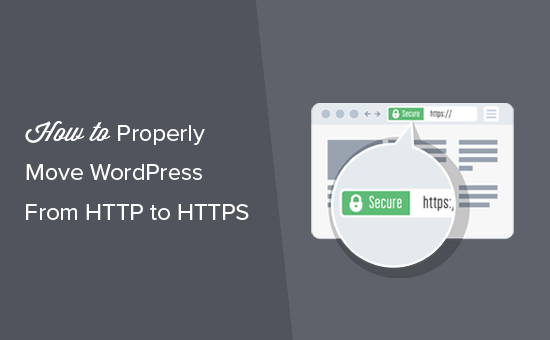
Aqui está uma rápida visão geral dos tópicos que abordaremos neste artigo:
- What Is HTTPS?
- Why Do You Need HTTPS and SSL?
- Requirements for Using HTTPS/SSL on a WordPress Site
- Setting Up WordPress to Use SSL and HTTPS
- Method 1: Setup SSL/HTTPS in WordPress Using a Plugin
- Method 2: Set Up SSL/HTTPS in WordPress Manually
- Submit Your HTTPS Site to Google Search Console
- Bonus Resources
- Video Tutorial
O que é HTTPS?
HTTPS, ou HTTP seguro, é um método de criptografia que protege a conexão entre o navegador de um usuário e o seu servidor. Essa segurança adicional torna muito mais difícil para os hackers interceptarem os dados que estão sendo transferidos.
Todos os dias, as pessoas compartilham dados pessoais com sites, seja para fazer compras ou simplesmente para fazer login. Vimos em primeira mão como é crucial proteger esse tipo de troca de dados.
Para garantir a segurança dos dados, é necessário estabelecer uma conexão segura.
É nesse ponto que o SSL e o HTTPS entram em ação.
Cada site recebe um certificado SSL exclusivo para identificação. Se um servidor tentar usar HTTPS sem um certificado válido ou se o certificado não corresponder, a maioria dos navegadores modernos alertará os usuários e os aconselhará a não prosseguir.
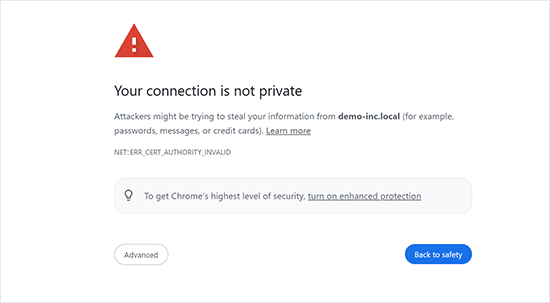
Agora, você deve estar se perguntando por que é necessário mudar seu site WordPress de HTTP para HTTPS, especialmente se for um blog simples ou um site de uma pequena empresa que não processa pagamentos.
Por que você precisa de HTTPS e SSL?
Em 2018, o Google anunciou uma iniciativa para aumentar a segurança na Web, incentivando os proprietários de sites a mudar de HTTP para HTTPS. Para apoiar essa mudança, seu navegador Chrome começou a marcar todos os sites sem um certificado SSL como “Não seguro”.
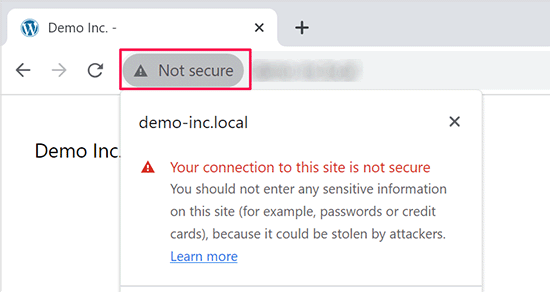
O Google também mencionou que os sites com SSL receberiam vantagens de SEO e poderiam alcançar classificações de pesquisa mais altas do que os sites não seguros. Esse anúncio levou muitos proprietários de sites a mudar para HTTPS.
Quando o aviso “Not Secure” foi lançado, o Chrome começou a sinalizar sites HTTP. Por exemplo, visitar um site HTTP no modo anônimo ou preencher um formulário de contato em um site HTTP aciona o aviso, marcando-o como inseguro.
Quando os visitantes veem esse aviso, isso pode deixar uma impressão negativa de seu site ou empresa.
É por isso que todos os sites precisam fazer a transição para HTTPS e instalar SSL o mais rápido possível.
Além disso, o SSL é obrigatório se você quiser aceitar pagamentos on-line em seu site de comércio eletrônico.
Provedores de pagamento como Stripe, PayPal Pro e Authorize.net exigem uma conexão de pagamento segura.
Garantimos que nossos próprios sites usem SSL, incluindo WPBeginner, OptinMonster, WPForms e MonsterInsights.
Requisitos para usar HTTPS/SSL em um site WordPress
Os requisitos para usar o SSL no WordPress não são muito altos. Tudo o que você precisa fazer é comprar um certificado SSL, e talvez você já o tenha gratuitamente.
As melhores empresas de hospedagem WordPress estão oferecendo certificados SSL gratuitos para todos os seus usuários:
Para obter mais detalhes, consulte nosso guia sobre como obter um certificado SSL gratuito para seu site WordPress.
Se a sua empresa de hospedagem não oferecer um certificado SSL gratuito, você precisará comprar um.
Recomendamos a Domain.com porque ela oferece a melhor oferta de SSL para certificados SSL regulares e curinga.
Ao adquirir um certificado SSL deles, você também recebe um selo de site TrustLogo para o seu site. Cada certificado SSL vem com uma garantia de segurança mínima de US$ 10.000. O preço começa em US$ 33 por ano, e os certificados SSL são renovados automaticamente.
Depois de adquirir um certificado SSL, você precisará solicitar ao provedor de hospedagem que o instale para você.
Precisa de ajuda para configurar o SSL e migrar para HTTPS?
Se você não tiver tempo para configurar o SSL, nosso serviçode Suporte Premium para WordPress está aqui para ajudar! Podemos cuidar de todo o processo para você, garantindo que seu site esteja seguro e pronto para receber visitantes.
- Taxa única
- Tempos de resposta rápidos
- Disponível sob demanda 24 horas por dia, 7 dias por semana
Você pode ficar tranquilo sabendo que seu site está em mãos especializadas. Entre em contato conosco hoje mesmo para obter a instalação perfeita de SSL e a migração para HTTPS!
Configuração do WordPress para usar SSL e HTTPS
Depois de ativar um certificado SSL para seu nome de domínio, você precisará configurar o WordPress para usar os protocolos SSL e HTTP em seu site.
Mostraremos dois métodos para fazer isso, e você pode escolher o que melhor atende às suas necessidades.
Método 1: Configurar SSL/HTTPS no WordPress usando um plug-in
Esse método é mais fácil e é recomendado para iniciantes.
Primeiro, você precisa instalar e ativar o plug-in Really Simple SSL. Para obter mais detalhes, consulte nosso guia passo a passo sobre como instalar um plug-in do WordPress.
Após a ativação, você precisa visitar a página Settings ” SSL. O plug-in detectará automaticamente seu certificado SSL e configurará seu site WordPress para usar HTTPS.
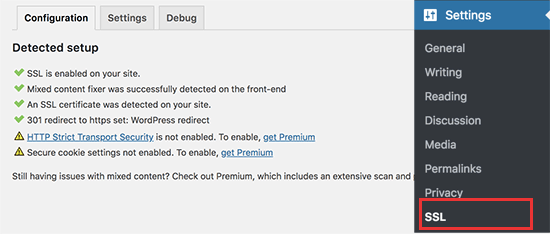
O plug-in cuidará de tudo, inclusive dos erros de conteúdo misto. Veja a seguir o que o plug-in faz nos bastidores:
- Verificar o certificado SSL
- Configure o WordPress para usar https em URLs
- Configurarredirecionamentos de HTTP para HTTPS
- Procure URLs em seu conteúdo que ainda estejam sendo carregados de fontes HTTP inseguras e tente corrigi-los.
Observação: o plug-in tenta corrigir erros de conteúdo misto usando uma técnica de buffer de saída. Isso pode ter um impacto negativo no desempenho porque substitui o conteúdo do site à medida que a página é carregada. Esse impacto é observado somente no primeiro carregamento da página e deve ser mínimo se você estiver usando um plug-in de cache.
Embora o plug-in diga que você pode manter o SSL e desativar o plug-in com segurança, isso não é 100% verdadeiro. Você terá que deixar o plug-in ativo o tempo todo, pois a desativação do plug-in trará de volta erros de conteúdo misto. Consulte nossa análise do Really Simple SSL para obter mais detalhes.
Método 2: Configurar SSL/HTTPS no WordPress manualmente
Esse método exige que você solucione os problemas manualmente e edite os arquivos do WordPress. No entanto, é uma solução permanente e mais otimizada em termos de desempenho, e estamos usando-a no WPBeginner.
Se achar esse método difícil, contrate um desenvolvedor de WordPress ou use o primeiro método.
Talvez seja necessário editar o tema e os arquivos de código do WordPress como parte desse método. Se você nunca fez isso antes, consulte nosso guia sobre como copiar e colar trechos de código no WordPress.
Primeiro, você precisa acessar a página Configurações ” Geral. Aqui, você precisa atualizar os campos de endereço de URL do WordPress e do site, substituindo http por https.
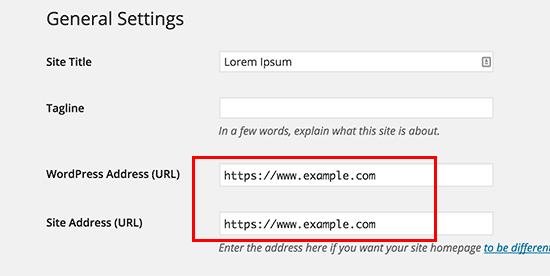
Não se esqueça de clicar no botão “Salvar alterações” para armazenar suas configurações.
Depois que as configurações forem salvas, o WordPress fará o logout e você será solicitado a refazer o login.
Em seguida, você precisa configurar os redirecionamentos do WordPress de HTTP para HTTPS adicionando o seguinte código ao seu arquivo .htaccess:
1 2 3 4 5 | <IfModule mod_rewrite.c>RewriteEngine OnRewriteCond %{HTTPS} offRewriteRule ^(.*)$ https://%{HTTP_HOST}%{REQUEST_URI} [L,R=301]</IfModule> |
Se você estiver usando servidores NGINX, precisará adicionar o seguinte código para redirecionar de HTTP para HTTPS em seu arquivo de configuração:
1 2 3 4 5 | server {listen 80;server_name example.com www.example.com;return 301 https://example.com$request_uri;} |
Não se esqueça de substituir example.com por seu nome de domínio.
Ao seguir essas etapas, você evitará o erro HTTPS not working do WordPress, pois o WordPress carregará todo o seu site usando HTTPS.
Se quiser forçar o SSL e o HTTPS na área de administração ou nas páginas de login do WordPress, você precisará configurar o SSL no arquivo wp-config.php.
Adicione o seguinte código acima da linha “That’s all, stop editing!” (Isso é tudo, pare de editar! ) em seu arquivo wp-config.php:
1 | define('FORCE_SSL_ADMIN', true); |
Essa linha permite que o WordPress force SSL / HTTPs na área de administração do WordPress. Ela também funciona em redes multisite do WordPress.
Depois de fazer isso, seu site estará totalmente configurado para usar SSL/HTTPS, mas você ainda encontrará erros de conteúdo misto.
Esses erros são causados por fontes (imagens, scripts ou folhas de estilo) que ainda estão sendo carregadas usando o protocolo HTTP inseguro nos URLs. Se esse for o caso, não será possível ver um ícone de cadeado seguro na barra de endereços do seu site.
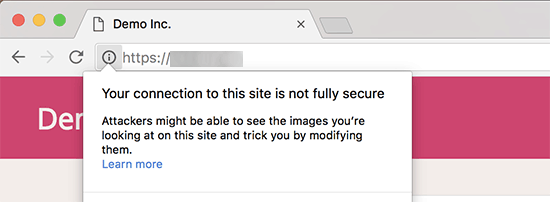
Muitos navegadores modernos bloqueiam automaticamente scripts e recursos não seguros.
Você poderá ver um ícone de cadeado, mas com uma notificação sobre isso na barra de endereços do navegador.
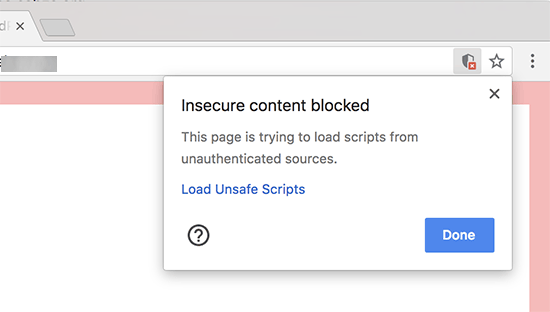
Você pode descobrir qual conteúdo é servido por meio de um protocolo inseguro usando a ferramenta Inspect.
O erro de conteúdo misto será exibido como um aviso no console com detalhes para cada item de conteúdo misto.
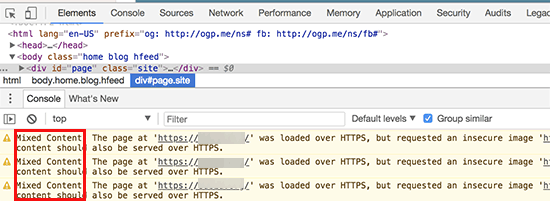
Você perceberá que a maioria dos URLs são imagens, iframes e galerias de imagens, enquanto alguns são scripts e folhas de estilo carregados pelos plug-ins e temas do WordPress.
Correção de conteúdo misto no banco de dados do WordPress
A maioria dos URLs incorretos será de imagens, arquivos, incorporações e outros dados armazenados no banco de dados do WordPress. Vamos corrigi-los primeiro.
Seria melhor se você encontrasse todas as menções do URL do seu site antigo no banco de dados que começam com HTTP e as substituísse pelo URL do seu novo site que começa com HTTPS.
Você pode fazer isso facilmente instalando e ativando o plug-in Search & Replace Everything. Para obter mais detalhes, consulte nosso guia passo a passo sobre como instalar um plug-in do WordPress.
Após a ativação, você precisa acessar a página Tools ” WP Search & Replace. No campo “Search” (Pesquisar), você precisa adicionar o URL do seu site com http. Depois disso, adicione o URL do seu site com https no campo “Replace” (Substituir).
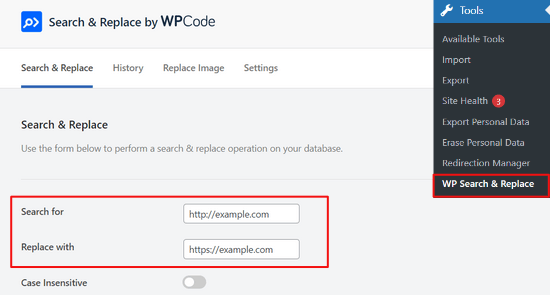
Abaixo disso, você verá todas as tabelas do banco de dados do WordPress.
Você precisa selecionar todos eles para fazer uma verificação completa.
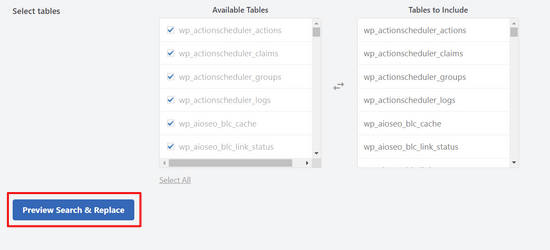
Em seguida, clique no botão “Preview Search & Replace” (Visualizar pesquisa e substituição) para ver todas as alterações que o plug-in fará.
Por fim, clique no botão “Replace All” (Substituir tudo).
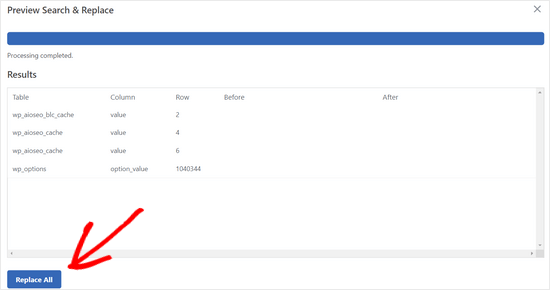
O plug-in agora pesquisará em seu banco de dados do WordPress os URLs que começam com http e os substituirá por URLs https seguros. Isso pode demorar um pouco, dependendo do tamanho do seu banco de dados do WordPress.
Correção de erros de conteúdo misto no tema do WordPress
Outro culpado comum que causa erros de conteúdo misto é o tema do WordPress. Qualquer tema decente do WordPress que siga os padrões de codificação do WordPress não causará esse problema.
Primeiro, você precisará usar a ferramenta Inspect do seu navegador para localizar os recursos e de onde eles estão sendo carregados.
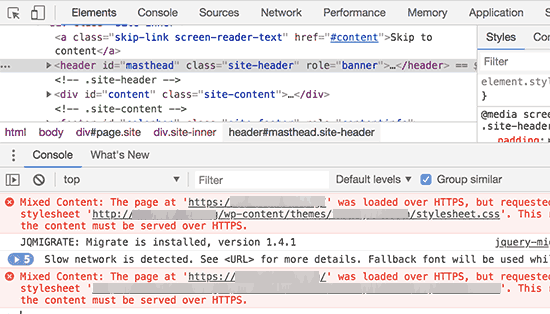
Depois disso, você precisará encontrá-los em seu tema do WordPress e substituí-los por https. Isso será um pouco difícil para a maioria dos iniciantes, pois você não conseguirá ver quais arquivos de tema contêm esses URLs.
Correção de erros de conteúdo misto causados por plug-ins
Alguns recursos de conteúdo misto serão carregados por plug-ins do WordPress. Qualquer plug-in do WordPress que siga os padrões de codificação do WordPress não causará erros de conteúdo misto.
Não recomendamos a edição de arquivos de plug-in do WordPress. Em vez disso, você deve entrar em contato com o autor do plug-in e informá-lo. Se eles não responderem ou não puderem corrigir o problema, você deverá encontrar uma alternativa adequada.
Observação: se, por algum motivo, você ainda estiver encontrando um erro de conteúdo misto, recomendamos usar temporariamente o plug-in Really Simple SSL para que seus usuários não sejam afetados enquanto você corrige o problema em um site de teste ou contrata um desenvolvedor.
Envie seu site HTTPS para o Google Search Console
Mecanismos de pesquisa como o Google consideram https e http como dois sites diferentes. Para evitar problemas de SEO, você precisará informar ao Google que seu site foi transferido.
Para fazer isso, basta acessar sua conta do Google Search Console e clicar no botão “Adicionar propriedade”.

Isso abrirá uma janela pop-up na qual você precisará adicionar o novo endereço https do seu site.
Há dois métodos de verificação de site: nome de domínio ou prefixo de URL. Recomendamos o método do prefixo do URL porque ele é mais flexível.
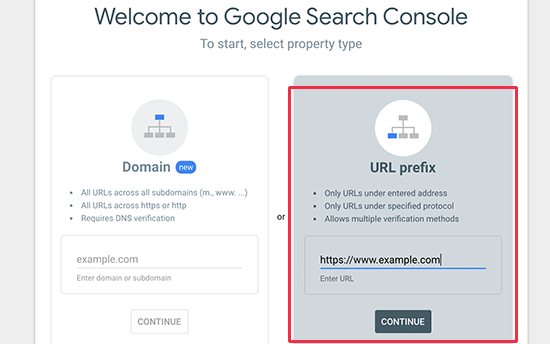
Depois disso, o Google solicitará que você verifique a propriedade do seu site.
Há várias maneiras de fazer isso. Selecione qualquer método e você receberá instruções para verificar seu site. Recomendamos usar o método de tag HTML.
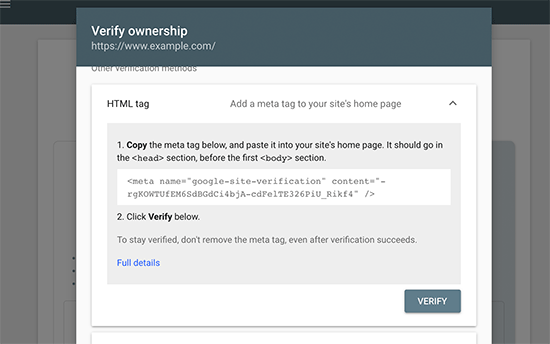
Agora você verá um trecho de código HTML que precisa ser adicionado à seção head do seu site WordPress.
Adicionar código de verificação do Search Console usando o All in One SEO
Primeiro, instale e ative o plug-in All in One SEO para WordPress. Para obter mais detalhes, consulte nosso tutorial sobre como instalar um plug-in do WordPress.
Observação: Há também uma versão gratuita do All in One SEO que você pode experimentar.
Após a ativação, vá para a página All in One SEO ” Configurações gerais e clique em Google Search Console.
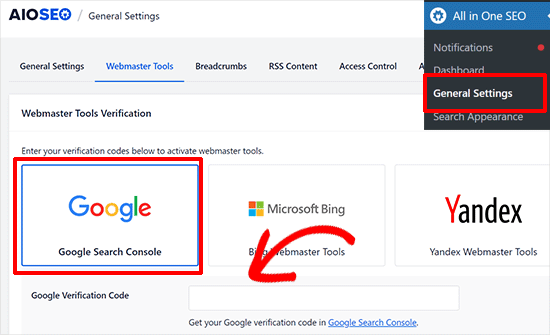
Em seguida, é necessário adicionar o código de verificação que você copiou anteriormente do site do Google Search Console.
Não se esqueça de clicar no botão “Save Changes” (Salvar alterações) para armazenar suas configurações.
Em seguida, volte para a guia Google Search Console e clique no botão “Verify” (Verificar).
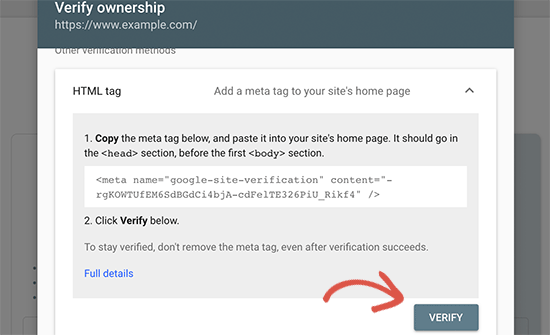
Depois que seu site for verificado, o Google mostrará os relatórios do console de pesquisa aqui.
Você também precisa garantir que as versões https e http sejam adicionadas ao Search Console.
Isso informa ao Google que você deseja que a versão https do seu site seja tratada como a versão principal. Combinado com os redirecionamentos 301 configurados anteriormente, o Google transferirá suas classificações de pesquisa para a versão https do seu site, e você provavelmente verá melhorias nas suas classificações de pesquisa.
Recursos de bônus
A seguir estão alguns recursos adicionais que podem ajudá-lo a corrigir problemas comuns do WordPress por conta própria e a aprender mais sobre o WordPress:
- Como corrigir problemas comuns de SSL no WordPress (guia para iniciantes)
- Erros mais comuns do WordPress e como corrigi-los
- TLS vs SSL: qual protocolo você deve usar para o WordPress?
- Como corrigir o erro de conexão segura no WordPress
Tutorial em vídeo
Esperamos que este artigo tenha ajudado você a adicionar HTTPS e SSL no WordPress. Talvez você também queira ver nosso guia definitivo de segurança do WordPress com instruções passo a passo para manter seu site WordPress seguro ou como renovar seu certificado SSL.
Se você gostou deste artigo, inscreva-se em nosso canal do YouTube para receber tutoriais em vídeo sobre o WordPress. Você também pode nos encontrar no Twitter e no Facebook.





Weslry
This article is a little bit trap for newbie because if you first change to https in your wp panel and then try to add those codelines to right files you can’t reach your webiste or wp admin panel. (443 error) I had to edit files through ftp and made myself fool at work for making such a mistake. So first you have to get the certificates and edit htaccess file etcetc and then add that S in your wp admin panel (or directly edit thorugh ftp).
Daryl
Thanks for heads up ! good article
Huseyn
Hi! Thank you for this article. Very useful!
But I was faced with one problem. After installing SSL (I use free version of Cloudflare SSL) I cannot edit any pages/posts/products. Does anybody face with such problem? And how did you solve it?
Thanks in advance!
Michael Penner
Thank you for the excellent and easy to understand article about WordPress and SSL. I was pleasantly surprised to see it was from one of my favorite plugin authors. Cheers!
WPBeginner Support
Hi Michael,
Glad you found it helpful
Admin
Maurizio Mau
Hi and many thanks for post,
i have implemented SSL, run good on all bowser included mobile, load in 1.5 sec, console upgraded, analitucs upgraded, redirect done, fixed all element but ranking drop approx 20% and above…
Onis Egwu
Hello There,
Wonderful article. The issue I have with using the .htaccess file to route through https is that whenever WordPress updates, it cleans off the edits done.
Is there a way to avoid this?
max
hi there,
i saw your post and is interesting..but i can’t understand one thing… I read you article and i made all about it … in admin area is ok all is https..
but the front end no .. i mean when i see the site with chrome the padlock appear and then disappear ???!??!?!
any ideas?
Hardy
I am having the same issue. :/
Swapan Kumar Manna
Hello,
I’ve purchased an SSL certificate form Godaddy and it is approved and downloaded the .crt file. I’m bit confused what are the next steps to install the file in the server and how to redirect all the URLs in the existing WordPress site. Can anyone give me the detailed guide step by step.
Also requesting WPBeginer to write an article on this topic “How to install SSL certificate in Godaddy.
Thanks.
Cathy Larkin
did you fix your issue? I am getting ready to do this. I thought GD did it for you?
Rohit
Hi, as you said I went to my wordpress blog settings page and changed my domain url to https from http and clicked save however Now I am not able to login to my wordpress dashboard and getting 404 error.
How can I solve this please becuase I cannot even login to my wordpress dashboard to change it back to http again
Abhay
Hello sir, I want to know why you are not using https on wpbeginner?
WPBeginner Support
Hi Abhay,
We don’t use HTTPS because we don’t collect any secure data. We do plan to change as our needs will change in the near future.
Admin
Pat B
Fantastically clear and helpful instructions. Many thanks!
Brody James
Hi,
This worked great after following your steps. However, I notice that a few pages i.e. contact page does not display the green SSL lock but still displays https://
How do I fix this?
Thanks
BJ
Vaggelis
That really rocked!!! Thank you so much. The https rocks


Esther
Thanks so much for this.
Amin
all SSL redirections have problems with cookies didn’t found a solution from a year now. can someone help ? plz ? there is a big problem on auth cookies .. and got redirect to reauth=1
there is no synch of cookies between front and backend , and authors get disconnected when they upload files .. I think it’s related to root/wp-load.php and /wp-admin/async-apload.php
Amritosh Pandey
Please try this –
# BEGIN WordPressRewriteEngine On
RewriteCond %{SERVER_PORT} !^443$
RewriteRule (.*) https://{HTTP_HOST}%{REQUEST_URI} [R=301,L]
RewriteBase /
RewriteRule ^index\.php$ - [L]
RewriteCond %{REQUEST_FILENAME} !-f
RewriteCond %{REQUEST_FILENAME} !-d
RewriteRule . /index.php [L]
# END WordPressJoe
This Worked for me in my .htaccess file, all I needed to do was to change the port to “80”
The htaccess snippet in the post just refused to work.
thanks for this.
Amy
Hi, just wanted to let you know I added Let’s Encrypt to my site and changed it in my WordPress dashboard it automagically updated the LOGIN page. I didn’t need to add the code to the wpconfig.php file.
I wonder if this is a new addition to WordPress?
Meenakshi
Hi,
I recently moved my WP site from WP’s free hosting to another hosting site, the issue I’m facing is with SSL. Any help from here is appreciated?
Daniel
What issues are you having?
sujith
Hi , after converting to https i am getting error like
“You do not have sufficient permissions to access this page” in wp-admin
Not able to access wp-admin.
When i revert the changes its working fine.
Can anybody please help
Bruce
My website is redirecting under
https to a different website and I cannot find where the redirect is.
Any ideas as to where to look would be appreciated.
I have tested the plugins by disabling them.
I have tested the themes by changing themes.
I have looked at the htaccess.
All works well except under https where it redirects to one of my other sites.
Any help appreciated.
Rrich
Hi,
I changed the wordpress and site address at the General settings tab at wordpress from http to https. And I can’t access my site again.
I now get your site is insecure when Ii type in he url.
I can’t even access the admin.
Please help
Karl D.
Don’t know if you got this fixed, but you can go into mysql (phpMyAdmin) and look for the table wp-options. There you will find a table entry titled “siteurl” and one titled “home” you can remove the s from https in the url there and your site will come back. I would make sure that you have the .htaccess and wp-config edited like stated in this article first and upload them to your site first and check if things work from there. If not, reset the .htaccess and wp-config file and edit the mysql like stated above and your site will come back when accessed without the https.
Good luck!
Best,
Karl D.
Kalle
Thanks Karl ! This worked ! I just edited the files in (phpMyAdmin) !
So if you mess with http / https settings with your wP try this !
I tried to edit my .httaccess file for 2-3 hours…..
Moty
After activation and change force admin ti https can’t login- Page Not found 401
can you please let me know how can I revert the changes?
thanks
Moty
I have erased the plugin via file manager,
Now can login to my wp admin but still can’t get into the plugins panel VIA Wp ,
it is asking for an https address
Please help
Thanks
Naeem Hussain
Dear Sir WPbeginner,
I installed SSL + dedicated IP Certificate to my Wp Website name computerpakistan.com. Now its everything working fine, But problem with my website page speed.
Before SSL Speed
1.8 seconds
After SSL Installation site page Speed
4.3 Secondes by gtmatrix report
Ritesh
I am not able to access the admin area after I uploaded define(‘FORCE_SSL_ADMIN’, true); to wp-config.php. My site was already using wordpress https plugin with force ssl administration checked in. I removed that plugin using ftp but I am still not able to login. It says incorrect username or password. However neither the password nor the username has been changed. I think this was the problem after I tried adding define(‘FORCE_SSL_ADMIN’, true); to wp-config.php. I can see the login page on https version of the site but not able to login. Please guide further.
Ritesh
Its absolutely blank page and nothing else.
The Platypus
I’m hopeful you ran a back up before doing any changes to your site.. in either case revert back your site to an earlier state via your database, and whatever back up of your config.php file you have.
Florin
I’m having the same problem. I checked everything but I still cannot login in my admin area.
Stephen
I had a similar problem after enabling FORCE_SSL_ADMIN in wp-config.php.
The login page etc. was coming up ok over HTTPS but it wouldn’t let me login successfully.
In this case, it was a plugin interfering – “Chap Secure Password Login”. After deactivating it, logins worked ok (and in fact, it’s not needed when WordPress is configured to force SSL on the admin page).
So I would suggest checking any login related plugins and try deactivating them.
Another issue is if you are using something like HAProxy in front of your webserver for load balancing, and get something like a “too many redirects” error message after trying to move WordPress to HTTPS.
In this case, you most likely need to modify wp-config.php to tell WordPress that the connection is actually HTTPS, otherwise it will keep trying to redirect even when the client connection is over HTTPS. There are some details here,
Monu
Hello sir I am using wordpress with https and www ……………….. in my site everthing is okay url of posts and pages are also use https but in google search results not show https in my website address only show http://www.example.com/post...
WPBeginner Support
You will need to inform Google about change of address from Google Webmaster Tools.
Admin
Raivat
Hi, I followed your tutorial. Thanks, Everything works! But I am getting an error when I load the home page saying “Your connection to this site is private, but someone on the network might be able to change the look of the page”. I checked it out and it seems there is a problem in one of my font resources which uses Google Fonts with http instead https, can you show me how can I fix this?
Thanks
Sebastian
Try removing the “http://” from the Google Font call. So it’s not being forced across HTTPS. The reference call to the Google Font link should start with the “www.” instead of “http://”
Naval Gupta
Should we use 301 redirect to redirect all http pages to https pages?
Mark Cohen
Everything working fine, except that when on Dashboard > Home I get exclamation mark across padlock in URL bar. Anyone know what content is being served insecurely on this page?
Joel
I made the changes in the site before I set up the certificate and now can not access the back end of my site.
David gillies
Hi followed your example and now cant access the website at all
if I try
all I get is jumbled page with no styling
WPBeginner Support
Instead of WordPress HTTPS SSL, please try Really Simple SSL plugin.
Admin
Adrienne
I need to do this soon for my nonprofit site, and I’m scared! Paying for this is going to be extra too, but I have to do it!. Thanks for this info….
Paying for this is going to be extra too, but I have to do it!. Thanks for this info….
Lourdes
So this comes up when I google my Blog Page. Using Bluehost/wordpress – DOES THIS MEAN O need to fix the SSL Cert issue aka buy from bluehost? Thank you!!!!
[We didn’t find any SSL certificate present on the website which is bad for users privacy. The site has a title but meta description is absent, it will be better for SEO if both are present. Homepage is in English.]
Maxim
Thanks for this post! Helped a lot!
Penny
What if you have Mixed Content going on and were asked to fix that before you proceed with installing SSL?
My Firewall, Sucuri said that I need to fix the mixed content before they can install the SSL. Now I’m stuck and do not know how to proceed. I’m nervous with installing plugins. They recommended really-simple-ssl plugin. Have you had any experience with this? I try to limit the using plugins…
Milon
Thanks BRO
Jarred
We installed the plugin WordPress HTTPS (SSL). We chose to only use SSL on specific pages option and everything is working great. However we have two important questions that came about after reading the GOOGLE article about migrating to https. Not sure if I can share link on here, so this is the title “Secure your site with HTTPS” on support google.
Questions.
1. Does the plugin WordPress HTTPS (SSL) automatically create 301 redirects to help search engines know we moved to https on those specific pages?
2. If the plugin does not create the 301 redirects, do WE need to go ahead and create the 301 redirects manually for those specific pages that we added SSL on? Thank you in advance
WPBeginner Support
See if the plugin is redirecting by checking it with an online redirect checker tool. If it isn’t, then you can setup your own redirects.
Admin
Jarred
I followed your advice and found a redirect tool. We used it and realized that the WordPress HTTPS (SSL) plugin DID in Fact create 301 redirects automatically. Great review and tutorial on this blog post and everything is working great. Thanks
WPBeginner Support
Glad you found it helpful
adam vikar
For a multisite setup, is there a code we can use to force SSL on the main site and NOT a specific subdomain?
Michelle
I put the wrong info in the SSL host box and now I get a 404 error. I cannot get back to any of my pages to disable the plugin or to change the info in the SSL host box. Please advise….
Easiest solution - delete the plug-in
The easiest solution is to delete the plug-in.
Access the files on your server (If you are using cPanel, you can use ‘File Manager’
Browse to where the plug-ins are kept
/wp-content/plugins
Find the plug-in and delete it.
Hiep Pro
You can use ftp client to delete plugin folder on web dir.
Jithin Johny George
Hi,
Awesome step-by-step guide.
But the plugin you have mentioned,WordPress HTTPS (SSL) has not updated in years.
Is there any alternative for the plugin ?
Thank You
Penny
I was advised by my firewall company to use Really Simple SSL. I haven’t tried it yet but they highly recommend it.
Kris Gabriel
Fantastic guide, simple and usefull.
The only thing to worry about is that the redirects causes the page to slow a bit down.
Is implementing the code listed above into the .access file the first choice or is it better with just a plugin?
I´ve chosen both options, that means both a wordpress https plugin AND .access code.
Would you say that is benicial or not?
Kind regards
Kris
Mursaleen Kamal
Assalam Alaikum Sir: We Have Been Successfully Implement this Guide on Our Website But We Still Facing Redirect issue,
Our Website Is Accessing from Both URL
http and https
and How to Resolve Mix Content Issue?
WPBeginner Support
Try really simple SSL plugin.
Admin
Ahmed Muhi
Thank you so much it worked.
Ali
Hello,
Thank you for your guide. I add this code in my htaccess file
RewriteEngine On
RewriteCond %{SERVER_PORT} 80
RewriteRule ^(.*)$ https://www.yoursite.com/$1 [R,L]
but now it do not do 301 redirect it is doing 302 redirect.
Please tell me is it ok to do 302 redirect or not.
Regards
WPBeginner Support
A 301 redirect means that the page has permanently moved to a new location. A 302 redirect means that the move is only temporary. Search engines need to figure out whether to keep the old page, or replace it with the one found at the new location.
Admin
Ana
Thanks for the article, but I should definitely have read it before adding the SSL and https to WP. Total newbie but somehow managing a wordpress site..
Changed WP site address on the settings page from http to https after an update recommendation on my admin panel. But now I can’t access the website or admin page! All I get is a blank page with the message ERR_TIMED_OUT and site can’t be reached.
I realised I hadn’t activated the free SSL certificate that comes with our web hoster. Now I have done that and I’ve tried adding a WP SSL redirect (http to https) code to the .htaccess file as well. And tried adding define force_SSL_admin to wp-config.php, but nothing has changed and I don’t know how to undo or fix the issue. Any suggestions or experience in this issue would be very helpful!
WPBeginner Support
Try using Really Simple SSL plugin.
Admin
mirko
sorry, but…I did not understand the part of .htaccess files … Must I add code to my htaccess or mix with my file ?
my original file is the default wordpress file
# BEGIN WordPressRewriteEngine OnRewriteBase /RewriteRule ^index\.php$ - [L]RewriteCond %{REQUEST_FILENAME} !-fRewriteCond %{REQUEST_FILENAME} !-dRewriteRule . /index.php [L]#ENDWordPress1-click Use in WordPress
The New file is correct ?
# BEGIN WordPressRewriteEngine OnRewriteCond %{SERVER_PORT} 80RewriteRule ^(.*)$ https://www.yoursite.com/$1 [R,L]RewriteEngine OnRewriteBase /RewriteRule ^index\.php$ - [L]RewriteCond %{REQUEST_FILENAME} !-fRewriteCond %{REQUEST_FILENAME} !-dRewriteRule . /index.php [L]#ENDWordPress1-click Use in WordPress
Thank you, Mirko
WPBeginner Support
The new file redirects your users to HTTPS
Admin
Jim
I’m a little unclear what needs to be in the htaccess file to force SSL
This is my current htacess
g
after changing the url in general settings, all css styles are gone, and the wp-login page to change this setting is not showing because of to many redirects. be aware before using this tut, I have to back up.
WPBeginner Support
Please see our guide on how to fix too many redirects error in WordPress.
Admin
Mark C
Hi, what about if we’re using it only for the login.php page, where do we configure it?
christopher
Thank you for your article! I was wondering though, my website recently has suffered some problems with “too many redirects” error. I wonder if adding the .htaccess code you mentioned in the article for ssl redirect will make the problem worse? Some visitors to my website said they often see “this page isn’t redirecting properly” when they come to our website. Could it be that our customers are having trouble visiting our website because I don’t have that code in my .htaccess file?
Melvin
Hi! I was wondering if there’s a reason why you only want SSL on specific pages instead of the whole website? Could this be because of performance?
Ahmed
Hello Syed! Great tutorial. I just want to ask that when ssl error window appears in browsers. Whether its the time to login,shopping or everytime you visit specific websit….For example if I have a blog which don’t offer login or shopping whteher ssl certificate is required or not???
WPBeginner Support
It is not required, but will certainly give you plus points in search results.
Admin
Jaclyn Mamuzich
Hello,
For some reason our blog is not showing as https even though we have an ssl installed and I thought it was done before the migration but I could be wrong. I followed the steps in the article (greatly appreciated but for some reason when I complete all the steps, almost all of my styling disappears, specifically related to layout. Any suggestions?
but for some reason when I complete all the steps, almost all of my styling disappears, specifically related to layout. Any suggestions?
thanks!
Rob
As with JACLYN MAMUZICH. I have followed all the steps and when the site is viewed in https:// all the CSS has gone. Any suggestions?